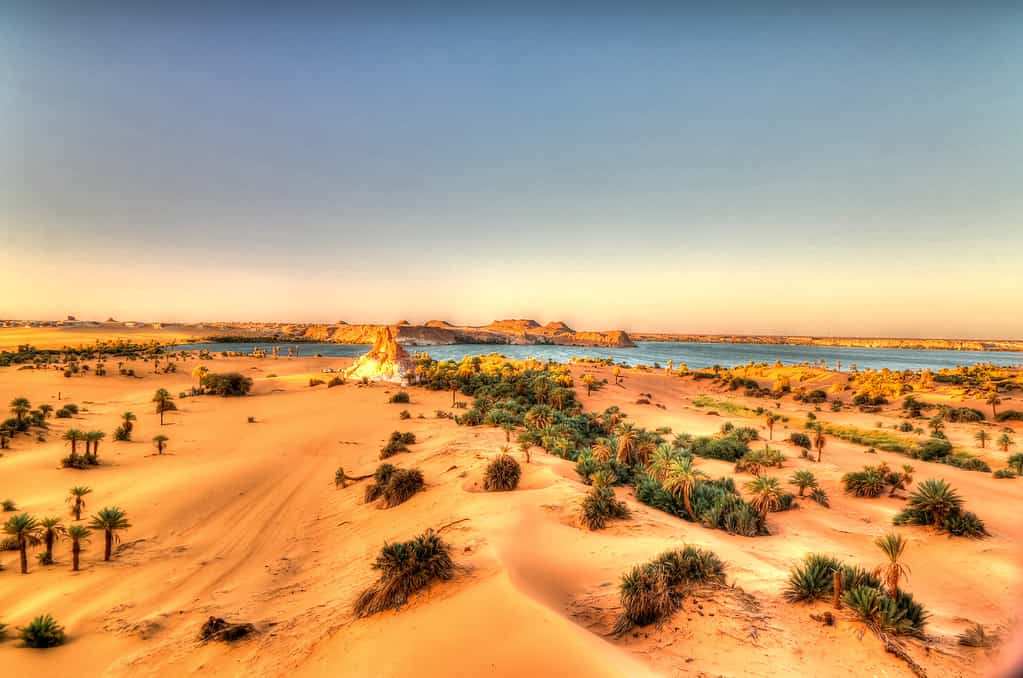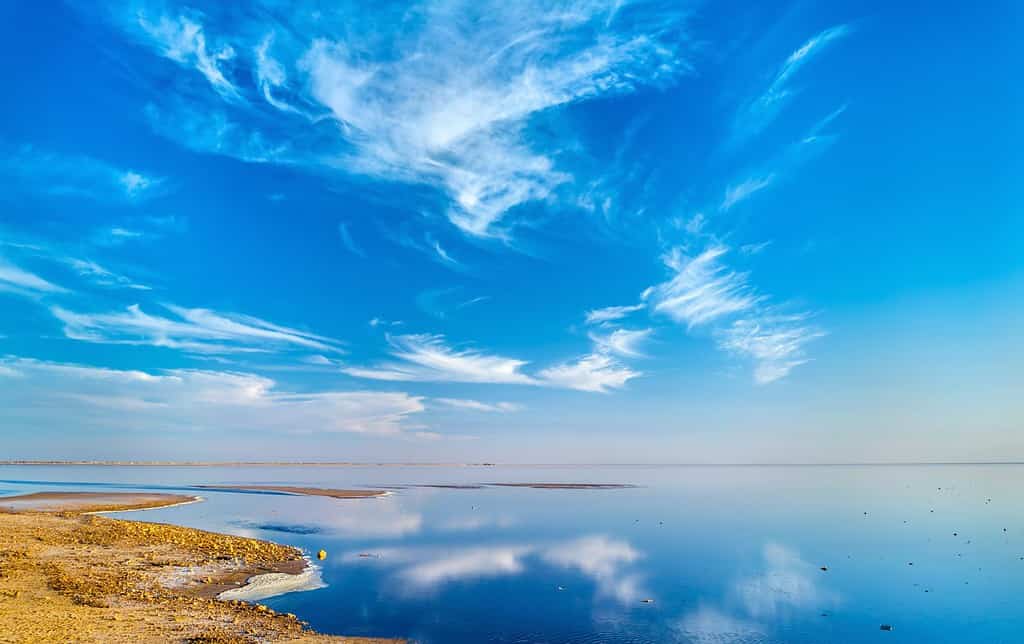Even though it is famous for its dry, arid climate, there are still some pretty remarkable lakes in Africa’s Sahara Desert. With more than 3.5 million square miles of desert, the Sahara is the largest desert in Africa and the third-largest desert in the world behind the Antarctic Desert and the Arctic Desert.
One of the most significant regions of lakes in the Sahara Desert is the Lakes of Ounianga. This collection of 18 lakes dates back to as early as the ice age. Because of the Sahara’s climate and little rainfall, the lakes have changed significantly over thousands of years. Today, they are small but historically significant parts of the Sahara.
Lake Chad

Although it is named for one of the countries where it is located, Lake Chad is actually part of four countries in
Africa
.
©NASA / This file is in the public domain in the United States because it was solely created by NASA. NASA copyright policy states that "NASA material is not protected by copyright unless noted". (See Template:PD-USGov, NASA copyright policy page or JPL Image Use Policy.) - License
This lake is actually in four countries: Chad, Nigeria, Niger, and Cameroon. It is a drainage basin for the surrounding area and holds fresh water. Lake Chad is as big as 1,900 square miles, although the exact size fluctuates a lot. At one point, it was more than 11,0000 square miles. However, climate change and human factors changed the landscape, including the massive Lake Chad. Deforestation and overgrazing impacted the land around Lake Chad and irrigation shifted water to other places. Within just a few decades, the lake was significantly smaller. However, it remains a key location for understanding the history of this part of Africa. Important artifacts and prehistoric sites were discovered around Lake Chad. Evidence of human settlement near the lake dates back to around 500 BC.
Lake Yoa

Lake Yoa is one of the lakes that are part of the Lakes of Ounianga.
©HomoCosmicos/iStock via Getty Images
Also located in Chad is Lake Yoa. It is one of the best-known lakes in the area, even though it is not very large. Lake Yoa occupies less than 2 square miles and is part of the Lakes of Ounianga in Chad. It is the largest and most significant of the lakes, which were designated a UNESCO World Heritage Site in 2012. These lakes are significant because of their location in a hyperarid part of the world. Even though the surrounding area gets less than 0.1 inches of rain each year, the lakes still exist due to the previous large lake and underground aquifer that created them. Each of the Lakes of Ounianga has a unique composition.
Lake Katam

Lake Katam is located in Chad, Africa.
Another one of the Lakes of Ounianga is Lake Katam. Along with its neighbor, Lake Yoa, this lake is part of the group of lakes in this region. Collectively, they were made a UNESCO World Heritage Site in 2012. At one point in the history of the region, human settlement occurred at the lakes. Evidence around the lakes shows that settlers may have tried to cultivate the area as early as 7,500 years ago. They erected barriers to try to keep the sand from reaching their crops and there is still evidence that they were there.
Lake Nasser

Lake Nasser is a manmade lake in Egypt and Sudan, named after the second President of Egypt.
This lake is located in Egypt and Sudan. It is man-made and and just over 2,000 square miles. Lake Nasser was formed after the completion of the Aswan High Dam across the Nile in 1970. Lake Nasser produces electricity for the region, specifically Egypt.
Toshka Lakes

The Toshka Lakes formed via canals as part of a planned project to deal with potential overflow from Lake Nasser.
Formed by overflow from Lake Nasser, the Toshka Lakes are more recent additions to the Sahara’s landscape compared to many of the prehistoric lakes in Africa. They are located in Egypt. The drainage basin that became the Toshka Lakes was built following a channel in 1978. This prevents uncontrolled flooding from occurring further down the Nile River. In total, the Toshka Lakes cover around 500 square miles. The individual lakes are not named and even as recently as 2001, new lakes were forming. Between 2001 and 2022, many of the lakes dried but then refilled to record levels following rain and floods.
Chott el Djerid

Chott el Djerid is an endorheic salt lake in Tunisia.
©Leonid Andronov/Shutterstock.com
Not all of the lakes in the Sahara Desert are there year round. This salt lake is only present in the winter. In the summer, it dries completely and leaves only the salt. It is the largest salt pan in the Sahara. In the summer, the temperatures can reach more than 120 degrees Fahrenheit. Along with almost no rainfall, this creates extremely arid conditions for the region. The result is evaporation that eliminates the chott during large portions of the year.
The photo featured at the top of this post is © Mik122/iStock via Getty Images
Thank you for reading! Have some feedback for us? Contact the AZ Animals editorial team.






